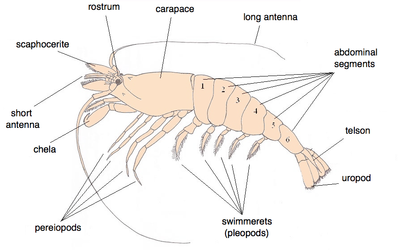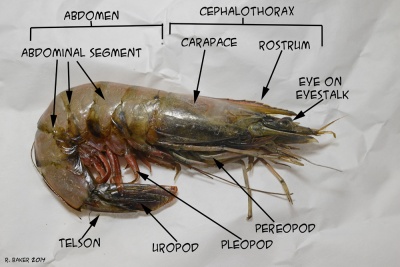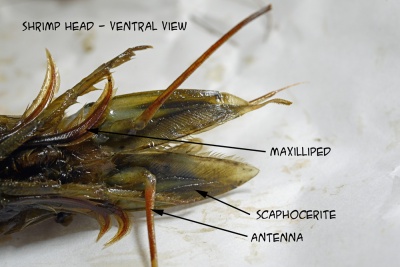AY Honors/Crustaceans/Answer Key
1. Name at least four characteristics of a crustacean.
Like all Arthropods, Crustaceans have an exoskeleton, a segmented body, and jointed limbs. Most crustaceans have biramous limbs (limbs that branch into two, rather than uniramous, or in a single series of segments), breath through gills, have two pair of antennae, have eyes on stalks, seven or more pairs of limbs, and mouths made up of one pair of mandibles and two pair of maxillae.
There are six classes of Crustacea:
Branchiopoda (this class includes the Triops, which are often available at science and hobby stores in grow-at-home kits)
Cephalocarida (the horseshoe shrimp)
Malacostraca (this is the group we often think of as crustaceans. It includes crabs, lobsters, true shrimp, krill, amphipods and isopods)
Maxillopoda (including the copepods and the barnacles)
Ostracoda (the seed shrimp, including the so-called "baked beans")
Remipedia (a small group of primarily blind crustaceans living in aquifers)
2. What is an exoskeleton?
An exoskeleton is the hard outside covering in crustaceans (and many other animals, including all of the arthropods). In crustaceans, the exoskeleton is made of the protein chitin, reinforced with calcium. Crustacean exoskeletons do not grow with the animal, thus as the animal grows, it must periodically shed (or molt) its exoskeleton. The crustacean is frequently vulnerable following the molt until its new exoskeleton hardens.
If you have ever seen "soft-shell crabs" listed at a restaurant or in a grocery store or fish market, these are crabs who have just molted, but their new exoskeletons have not yet hardened.
3. What phylum does this group belong to?
Crustaceans are classified in the Kingdom Animalia, Phylum Arthropoda, Subphylum Crustacea.
4. How are the body of these animals divided?
Like all Arthropods, Crustacean bodies are made of three main divisions - the Head, Thorax and Abdomen. In many crustaceans, the head and thorax are fused into a cephalothorax. Each body division can be composed of several segments, each segment often having its own pair of appendages. The abdomen in crustaceans such as shrimp and lobsters is hinged in many segments, allowing them greater flexibility. In crabs, the abdomen is often folded under the animal, making them appear tail-less.
5. In which Bible passages can information be found about consuming crustaceans?
Discussions on eating crustaceans can be found in Mosaic food regulations in Leviticus 11:9-12 and Deuteronomy 14:9-10. God forbids eating them.
6. How are a siri and a crab different? Where can these animals be found?
Siri is another word for swimming crabs, in the family Portunidae. The five pairs of limbs in crabs are referred to as pereopods. The first pair are the chelipeds, or claws. The next four pair are designed for locomotion. In walking crabs, all four pair are similar, ending in points and used for walking. In swimming crabs (siri), the last pair is flattened and oar-like, allowing the crabs to move through the water. Swimming crabs are found in many marine environments around the world, often in near shore areas with sandy bottoms. Walking crabs are found in both sandy and rocky areas offshore and onshore.
Common swimming crabs (siri) on the U.S. coast include the Blue Crab (Callinectes sapidus) and the Lady Crab (Ovalipes ocellatus).
7. Name a land crab.
Ghost Crabs (Ocypode sp.) and Blue Land Crabs (Cardisoma guanhumi) are common land crabs along the U.S. south and east coasts. Most types of Fiddler Crabs (the male frequently has one claw much larger than the other) are also considered land or terrestrial crabs.
8. How can you tell the difference between a male and female siri? Why is it important?
The tail flap that folds under the abdomen is much wider in female swimming crabs than in male swimming crabs. This wider flap is used for carrying eggs in the female.
9. What is the importance of small crustaceans for the environment?
Small crustaceans serve several important roles. They are often the first level of consumers in trophic webs, eating algae and phytoplankton, or serving as scavengers eating detritus and other decaying and waste material. As such, they are a critical component in keeping marine environments clean. But small crustaceans are also a very important component of the food webs as a source of nourishment for progressively larger animals, and crustaceans are among the most abundant organisms in numbers and weight in marine environments.
Perhaps the most striking relationship is between the Blue Whale and the crustacean Krill, one of its primary food sources. Blue whales can eat between two and four tons of krill a day, and by some accounts can, in particularly rich waters, gulp an astonishing thousand pounds of krill in a single mouthful.
10. Complete one of the following activities and present an illustrated report:
a. Dissect a shrimp and identify its main parts.
You should be able to acquire shrimp from a local grocery store or fish market. A basic dissection kit is ideal, but you can also use small hobby knives or a razor blade, small scissors, tweezers and toothpicks or bamboo skewers for dissection. Begin with a review of the external anatomy, and the way the various parts cooperate to provide different types of locomotion, protection and feeding for the shrimp. Then you can remove the carapace to see the stomach and heart (in previously frozen shrimp, which are common in the grocery, these organs may be damaged, but are still generally identifiable). Cutting through the shrimp abdomen will allow you to see the gut and the nerves, as well as note the extensive amount of muscle in a shrimp. If you are careful and interested, you can slowly remove the various mouth parts. Shrimp, like many of their cousin Malacostraca, have very complex mouths, with different modified limbs serving to move the food ultimately to the crushing mandibles.
b. In a class, observe various kinds of crustaceans. Sketch at least two of them.
Your local grocery store or seafood market is your best bet to get live specimens to observe. have fun.
11. Be able to identify in person or by pictures the following animals:
a. Barnacle
b. Hermit crab
c. Woodlouse
d. Lobster
e. Shrimp
Shrimp are slender with long muscular abdomens. They look somewhat like small lobsters, but not like crabs. The abdomens of crabs are small and short, whereas the abdomens of lobsters and shrimp are large and long. The lower abdomens of shrimp support pleopods which are well adapted for swimming. The carapace of crabs are wide and flat, whereas the carapace of lobsters and shrimp are more cylindrical. The antennae of crabs are short, whereas the antennae of lobsters and shrimp are usually long, reaching more than twice the body length in some shrimp species.

















